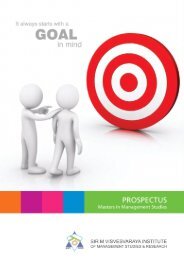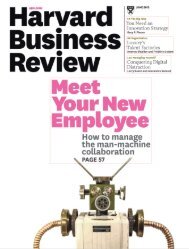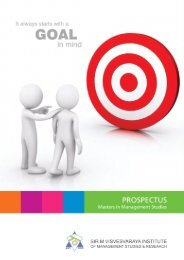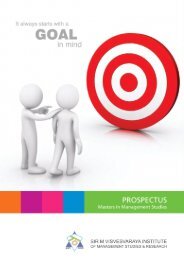+ + +
You also want an ePaper? Increase the reach of your titles
YUMPU automatically turns print PDFs into web optimized ePapers that Google loves.
INNOVATORS<br />
LEADERSHIP<br />
“There is no such thing as a pure<br />
extrovert or a pure introvert,” argued<br />
Carl Jung, the pioneering psychologist<br />
credited with popularizing the concepts<br />
of extroversion and introversion almost<br />
a century ago. “Such a man would be in<br />
the lunatic asylum.”<br />
Public perception notwithstanding,<br />
Ballmer is probably an ambivert. The<br />
majority of other successful entrepreneurs<br />
and corporate leaders are most<br />
likely ambiverts as well—and chances<br />
are you are, too. Neither fish nor fowl,<br />
ambiverts occupy the expansive space<br />
between the polar extremes of extroversion<br />
and introversion, embodying and<br />
adopting key attributes of both psychological<br />
archetypes. For example, ambiverts<br />
are uniquely equipped to move comfortably<br />
between raucous social settings<br />
and intense solitude, and while they<br />
know how to assert their opinions, they<br />
refrain from being aggressive or boorish.<br />
“If you look at something like [personality<br />
test] Myers-Briggs or even the popular<br />
parlance of ‘introvert’ and ‘extrovert,’<br />
the wisdom is you’re either one or the<br />
other. That cuts against a lot of people’s<br />
experiences,” says Daniel Pink, whose<br />
2012 book, To Sell Is Human: The Surprising<br />
Truth About Moving Others, addresses<br />
ambiversion as it explores the complexities<br />
of salesmanship. “What I like about<br />
‘ambivert’ is it reflects that introversion<br />
and extroversion are really a spectrum.<br />
People are located at different spots along<br />
that spectrum. It’s a more accurate way of<br />
describing who people really are.”<br />
THE AMBIVERT ADVANTAGE<br />
One’s location on the spectrum can play<br />
a dramatic role in professional prowess.<br />
“Rethinking the Extraverted Sales Ideal:<br />
The Ambivert Advantage,” a 2013<br />
research paper by Adam Grant, a professor<br />
at The University of Pennsylvania<br />
Wharton School, tracked sales representatives<br />
at an unnamed software company<br />
over the span of three months. Using a<br />
personality assessment test, it measured<br />
introversion and extroversion on a scale<br />
from 1 to 7. Ambiverts—sales reps who<br />
scored between 3.75 and 5.50—had<br />
average hourly revenue of $154.77, far<br />
surpassing their extroverted ($125.19<br />
SOUNDS LIKE ME<br />
Given that ambiverts account for a larger percentage of the population than either<br />
extroverts or introverts, it stands to reason that most successful entrepreneurs<br />
line up somewhere near the middle of the personality spectrum. Whether they<br />
self-identify as ambiverts is another story.<br />
“My guess is that most entrepreneurs would say,<br />
‘I’m introverted, but I do like going out and talking<br />
to people and hearing what they have to say’ or<br />
‘I’m a natural extrovert, but I love being by myself<br />
and reading,’” says Daniel Pink, whose books<br />
include To Sell Is Human: The Surprising Truth<br />
About Moving Others. “Most people don’t have the<br />
word ‘ambivert’ in their vocabulary. If you ask, ‘Are<br />
you an introvert or an extrovert?’ and that’s the only<br />
vocabulary you know, you have to pick one. But if you<br />
add ambivert to the mix, a lot of people will say,<br />
‘That’s a choice? That’s allowed? Then yeah, I’m<br />
an ambivert!’”<br />
per hour) and introverted ($120.10)<br />
colleagues. Most telling, however: The<br />
employees who scored at the exact midpoint<br />
of 4.0 averaged $208.34 per hour,<br />
considerably more than any other subset.<br />
The same middle-of-the-road psychological<br />
profile that helps make ambiverts<br />
outstanding salespeople extends to other<br />
facets of professional life, including entrepreneurial<br />
leadership, experts say.<br />
“We have data suggesting that if you<br />
go all out on the extroversion side, you’re<br />
going to be worse at leading and worse<br />
at selling, and leading and selling are at<br />
the heart of what an entrepreneur has to<br />
do,” Grant says. “[In ambiverts] you see a<br />
good balance between talking and listening.<br />
Extroverts make the mistake of dominating<br />
the conversation and not hearing<br />
enough ideas from the people around<br />
them. Introverts make the opposite error<br />
of staying quiet too often and not bringing<br />
their ideas forward. A mix of that can be<br />
pretty helpful when it comes to generating<br />
ideas for what visions and strategies<br />
your startup should be pursuing—or<br />
when it comes to pitching investors.”<br />
LEADERSHIP ROLES<br />
The term “ambivert” first appeared in<br />
sociologist Kimball Young’s Source Book<br />
for Social Psychology, published in<br />
1927—six years after Jung’s groundbreaking<br />
Psychological Types, which outlined<br />
his theories on extroverts and introverts.<br />
“There is, finally, a third group, and here<br />
it is hard to say whether the motivation<br />
comes chiefly from within or without,”<br />
Jung wrote. “This group is the most<br />
numerous and includes the less differentiated<br />
normal man.”<br />
Subsequent contributions to the<br />
ambivert literature are scarce across the<br />
decades that follow, with psychologists<br />
like Hans Eysenck instead focusing attention<br />
on extroversion and introversion.<br />
Eysenck’s influential 1947 book,<br />
Dimensions of Personality, proposed that<br />
extroverts operate at a lower basic rate of<br />
cortical arousal than introverts, requiring<br />
extroverts to work harder to energize<br />
their minds and bodies, and in turn leading<br />
them to crave adventure, social activity<br />
and other thrill-seeking stimuli.<br />
That insight into the extrovert<br />
dynamic may explain why magnetic,<br />
larger-than-life personalities like Sir<br />
Richard Branson, Donald Trump and<br />
Mark Cuban were so long identified as<br />
exemplars of the entrepreneurial ideal.<br />
Conventional wisdom held that extroverts<br />
translated as more effective leaders simply<br />
because their outgoing personalities<br />
made them better suited to networking,<br />
public speaking and collaboration. But<br />
the pendulum shifted following the 2012<br />
publication of Susan Cain’s Quiet: The<br />
Power of Introverts in a World That Can’t<br />
Stop Talking. Virtually overnight, pundits<br />
began arguing that introverts are in fact<br />
better engineered to run businesses<br />
because they are more focused, more<br />
risk-averse and more willing to listen to<br />
constructive criticism.<br />
But according to Grant’s research,<br />
neither perspective is correct. “When you<br />
look at the personality scores of effective<br />
leaders in studies that my colleagues<br />
and I did, they’re not extreme introverts.<br />
They actually scored more in the middle,”<br />
he says. “We saw that the leaders who<br />
were less extroverted—or in this case,<br />
ILLUSTRATION © SHUTTERSTOCK/PATRICE6000<br />
38 ENTREPRENEUR MARCH 2015






